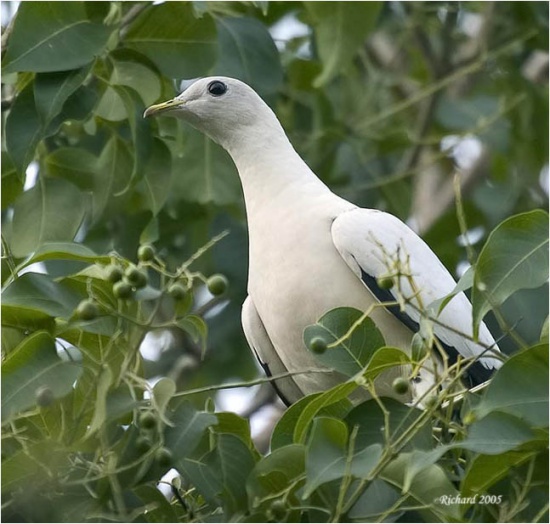m |
(All sections now started. Flight picture. References. Incomplete gone) |
||
| Line 1: | Line 1: | ||
| − | |||
'''Alternatives names: Yellow-tinted Imperial-Pigeon (subflavescens); Yellowish Imperial-Pigeon (subflavescens)''' | '''Alternatives names: Yellow-tinted Imperial-Pigeon (subflavescens); Yellowish Imperial-Pigeon (subflavescens)''' | ||
| + | [[Image:Torresian_Imperial_Pigeon.jpg|thumb|550px|right|Photo by {{user|RMD|RMD}}<br />Nhulunbuy, [[Northern Territory]], [[Australia]], April 2004]] | ||
;[[:Category:Ducula|Ducula]] spilorrhoa | ;[[:Category:Ducula|Ducula]] spilorrhoa | ||
| − | |||
==Identification== | ==Identification== | ||
| + | 38–44 cm (15-17¼ in) | ||
| + | *White overall plumage | ||
| + | *Creamy or greyish wash over head and neck | ||
| + | *Black outer wing and [[Topography#Wings|secondaries]] | ||
==Distribution== | ==Distribution== | ||
| − | [[Australia]], [[Indonesia]] | + | [[Australia]], [[Indonesia]] and [[Papua New Guinea]]. |
| + | ==Taxonomy== | ||
| + | [[Image:4370Pied Imperial Pigeon 4.jpg|thumb|350px|right|Photo by {{user|mehdhalaouate|mehdhalaouate}}<br />Supiori, [[Indonesia]], August 2004]] | ||
| + | This species is sometimes considered [[Dictionary_A-C#C|conspecific]] with [[Pied Imperial-Pigeon]]. | ||
| + | ====Subspecies==== | ||
| + | Clements accepts two subspecies<sup>[[#References|[1]]]</sup>:: | ||
| + | *''D. s. subflavescens'': | ||
| + | :*Bismarck Archipelago and Admiralty Islands | ||
| + | *''D. s. spilorrhoa'': | ||
| + | :*Aru Islands, [[New Guinea]] and adjacent islands to northern and north-eastern [[Australia]] | ||
| − | + | ||
| − | + | The first is sometimes split as '''Yellow-tinted Imperial-Pigeon''' or '''Yellowish Imperial Pigeon''', ''Ducula subflavescens''. However, this split was only accepted by Sibley and Monroe and Gill and Donsker. | |
| − | |||
| − | |||
| − | The first is sometimes split as '''Yellow-tinted Imperial-Pigeon''' or '''Yellowish Imperial Pigeon''', ''Ducula subflavescens''. However, this split was only accepted by Sibley and Monroe and Gill and Donsker | ||
| − | |||
==Habitat== | ==Habitat== | ||
Moist lowland forests, mangrove forests, and swamps. | Moist lowland forests, mangrove forests, and swamps. | ||
==Behaviour== | ==Behaviour== | ||
| + | ====Diet==== | ||
| + | They are frugivorous, eating a wide variety of fruits from trees, vines and shrubs. | ||
| + | ==References== | ||
| + | #{{Ref-Clements6thAug17}}#Handbook of the Birds of the World Alive (retrieved Nov 2017) | ||
| + | {{ref}} | ||
==External Links== | ==External Links== | ||
{{GSearch|Ducula+spilorrhoa}} | {{GSearch|Ducula+spilorrhoa}} | ||
[[Category:Birds]] [[Category:Ducula]] | [[Category:Birds]] [[Category:Ducula]] | ||
Revision as of 23:53, 29 November 2017
Alternatives names: Yellow-tinted Imperial-Pigeon (subflavescens); Yellowish Imperial-Pigeon (subflavescens)
- Ducula spilorrhoa
Identification
38–44 cm (15-17¼ in)
- White overall plumage
- Creamy or greyish wash over head and neck
- Black outer wing and secondaries
Distribution
Australia, Indonesia and Papua New Guinea.
Taxonomy
This species is sometimes considered conspecific with Pied Imperial-Pigeon.
Subspecies
Clements accepts two subspecies[1]::
- D. s. subflavescens:
- Bismarck Archipelago and Admiralty Islands
- D. s. spilorrhoa:
- Aru Islands, New Guinea and adjacent islands to northern and north-eastern Australia
The first is sometimes split as Yellow-tinted Imperial-Pigeon or Yellowish Imperial Pigeon, Ducula subflavescens. However, this split was only accepted by Sibley and Monroe and Gill and Donsker.
Habitat
Moist lowland forests, mangrove forests, and swamps.
Behaviour
Diet
They are frugivorous, eating a wide variety of fruits from trees, vines and shrubs.
References
- Clements, J. F., T. S. Schulenberg, M. J. Iliff, D. Roberson, T. A. Fredericks, B. L. Sullivan, and C. L. Wood. 2017. The eBird/Clements checklist of birds of the world: v2017, with updates to August 2017. Downloaded from http://www.birds.cornell.edu/clementschecklist/download/
- Handbook of the Birds of the World Alive (retrieved Nov 2017)
Recommended Citation
- BirdForum Opus contributors. (2024) Torresian Imperial Pigeon. In: BirdForum, the forum for wild birds and birding. Retrieved 26 April 2024 from https://www.birdforum.net/opus/Torresian_Imperial_Pigeon





